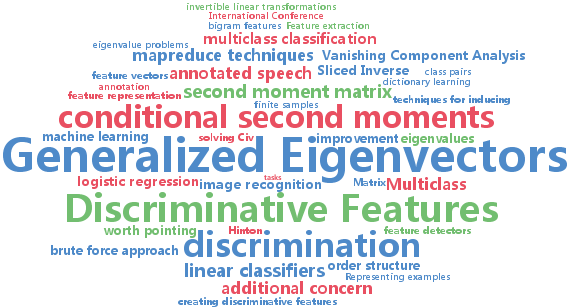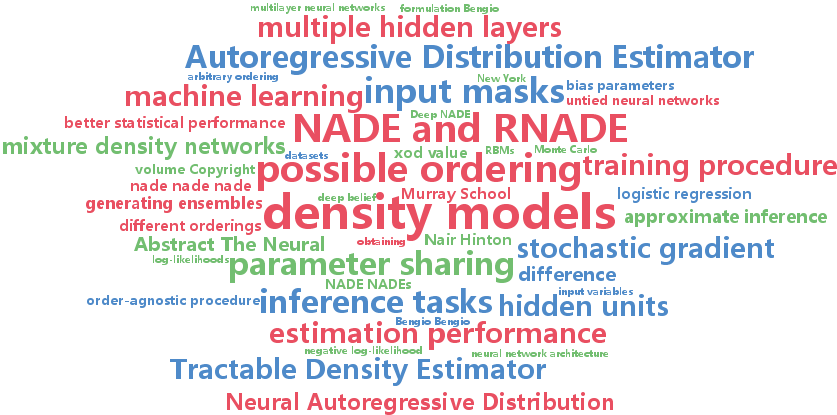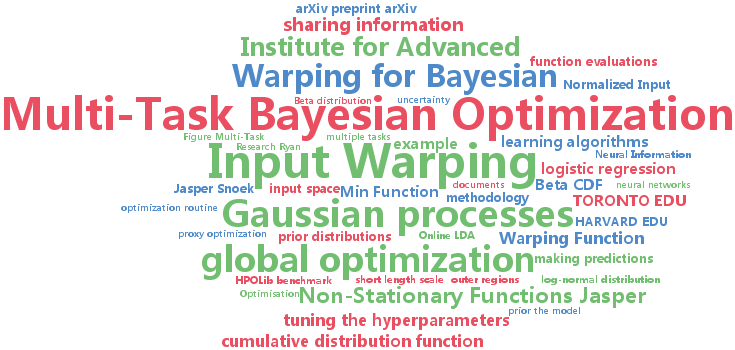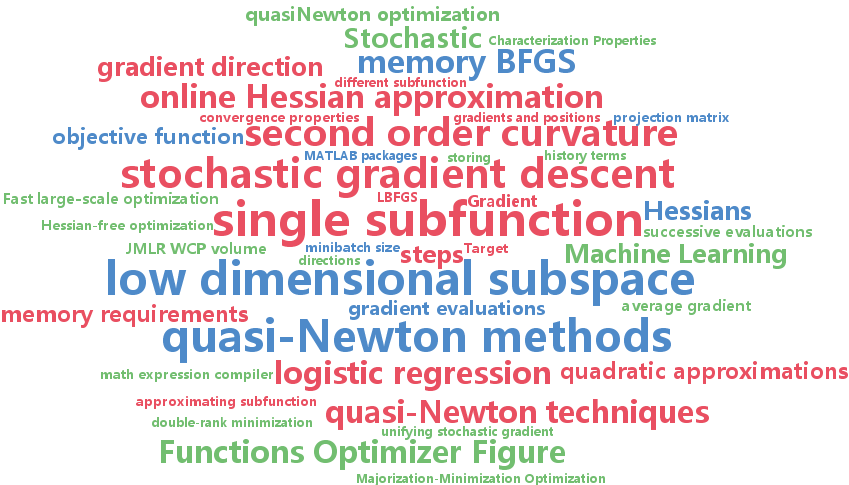logistic regression
-
Quoc Le and Tomas Mikolov
Distributed Representations of Sentences and Documents (pdf)
Many machine learning algorithms require the input to be represented as a fixed length feature vector. When it comes to texts, one of the most common representations is bag-of-words. Despite their popularity, bag-of-words models have two major weaknesses: they lose the ordering of the words and they also ignore semantics of the words. For example, "powerful," "strong" and "Paris" are equally distant. In this paper, we propose an unsupervised algorithm that learns vector representations of sentences and text documents. This algorithm represents each document by a dense vector which is trained to predict words in the document. Its construction gives our algorithm the potential to overcome the weaknesses of bag-of-words models. Empirical results show that our technique outperforms bag-of-words models as well as other techniques for text representations. Finally, we achieve new state-of-the-art results on several text classification and sentiment analysis tasks.
-
Nikos Karampatziakis and Paul Mineiro
Discriminative Features via Generalized Eigenvectors (pdf)
Representing examples in a way that is compatible with the underlying classifier can greatly enhance the performance of a learning system. In this paper we investigate scalable techniques for inducing discriminative features by taking advantage of simple second order structure in the data. We focus on multiclass classification and show that features extracted from the generalized eigenvectors of the class conditional second moments lead to classifiers with excellent empirical performance. Moreover, these features have attractive theoretical properties, such as inducing representations that are invariant to linear transformations of the input. We evaluate classifiers built from these features on three different tasks, obtaining state of the art results.
-
Benigno Uria and Iain Murray and Hugo Larochelle
A Deep and Tractable Density Estimator (pdf)
The Neural Autoregressive Distribution Estimator (NADE) and its real-valued version RNADE are competitive density models of multidimensional data across a variety of domains. These models use a fixed, arbitrary ordering of the data dimensions. One can easily condition on variables at the beginning of the ordering, and marginalize out variables at the end of the ordering, however other inference tasks require approximate inference. In this work we introduce an efficient procedure to simultaneously train a NADE model for each possible ordering of the variables, by sharing parameters across all these models. We can thus use the most convenient model for each inference task at hand, and ensembles of such models with different orderings are immediately available. Moreover, unlike the original NADE, our training procedure scales to deep models. Empirically, ensembles of Deep NADE models obtain state of the art density estimation performance.
-
CORINNA CORTES and Mehryar Mohri and Umar Syed
Deep Boosting (pdf)
We present a new ensemble learning algorithm, DeepBoost, which can use as base classifiers a hypothesis set containing deep decision trees, or members of other rich or complex families, and succeed in achieving high accuracy without overfitting the data. The key to the success of the algorithm is a 'capacity-conscious' criterion for the selection of the hypotheses. We give new data-dependent learning bounds for convex ensembles expressed in terms of the Rademacher complexities of the sub-families composing the base classifier set, and the mixture weight assigned to each sub-family. Our algorithm directly benefits from these guarantees since it seeks to minimize the corresponding learning bound. We give a full description of our algorithm, including the details of its derivation, and report the results of several experiments showing that its performance compares favorably to that of AdaBoost and Logistic Regression and their L_1-regularized variants.
-
Jasper Snoek and Kevin Swersky and Rich Zemel and Ryan Adams
Input Warping for Bayesian Optimization of Non-Stationary Functions (pdf)
Bayesian optimization has proven to be a highly effective methodology for the global optimization of unknown, expensive and multimodal functions. The ability to accurately model distributions over functions is critical to the effectiveness of Bayesian optimization. Although Gaussian processes provide a flexible prior over functions, there are various classes of functions that remain difficult to model. One of the most frequently occurring of these is the class of non-stationary functions. The optimization of the hyperparameters of machine learning algorithms is a problem domain in which parameters are often manually transformed a priori, for example by optimizing in "log-space", to mitigate the effects of spatially-varying length scale. We develop a methodology for automatically learning a wide family of bijective transformations or warpings of the input space using the Beta cumulative distribution function. We further extend the warping framework to multi-task Bayesian optimization so that multiple tasks can be warped into a jointly stationary space. On a set of challenging benchmark optimization tasks, we observe that the inclusion of warping greatly improves on the state-of-the-art, producing better results faster and more reliably.
-
Jascha Sohl-Dickstein and Ben Poole and Surya Ganguli
Fast large-scale optimization by unifying stochastic gradient and quasi-Newton methods (pdf)
We present an algorithm for minimizing a sum of functions that combines the computational efficiency of stochastic gradient descent (SGD) with the second order curvature information leveraged by quasi-Newton methods. We unify these disparate approaches by maintaining an independent Hessian approximation for each contributing function in the sum. We maintain computational tractability and limit memory requirements even for high dimensional optimization problems by storing and manipulating these quadratic approximations in a shared, time evolving, low dimensional subspace. This algorithm contrasts with earlier stochastic second order techniques that treat the Hessian of each contributing function as a noisy approximation to the full Hessian, rather than as a target for direct estimation. Each update step requires only a single contributing function or minibatch evaluation (as in SGD), and each step is scaled using an approximate inverse Hessian and little to no adjustment of hyperparameters is required (as is typical for quasi-Newton methods). We experimentally demonstrate improved convergence on seven diverse optimization problems. The algorithm is released as open source Python and MATLAB packages.
-
Ling Yan and Wu-Jun Li and Gui-Rong Xue and Dingyi Han
Coupled Group Lasso for Web-Scale CTR Prediction in Display Advertising (pdf)
In display advertising, click through rate(CTR) prediction is the problem of estimating the probability that an advertisement (ad) is clicked when displayed to a user in a specific context. Due to its easy implementation and promising performance, logistic regression(LR) model has been widely used for CTR prediction, especially in industrial systems. However, it is not easy for LR to capture the nonlinear information, such as the conjunction information, from user features and ad features. In this paper, we propose a novel model, called coupled group lasso(CGL), for CTR prediction in display advertising. CGL can seamlessly integrate the conjunction information from user features and ad features for modeling. Furthermore, CGL can automatically eliminate useless features for both users and ads, which may facilitate fast online prediction. Scalability of CGL is ensured through feature hashing and distributed implementation. Experimental results on real-world data sets show that our CGL model can achieve state-of-the-art performance on web-scale CTR prediction tasks.






